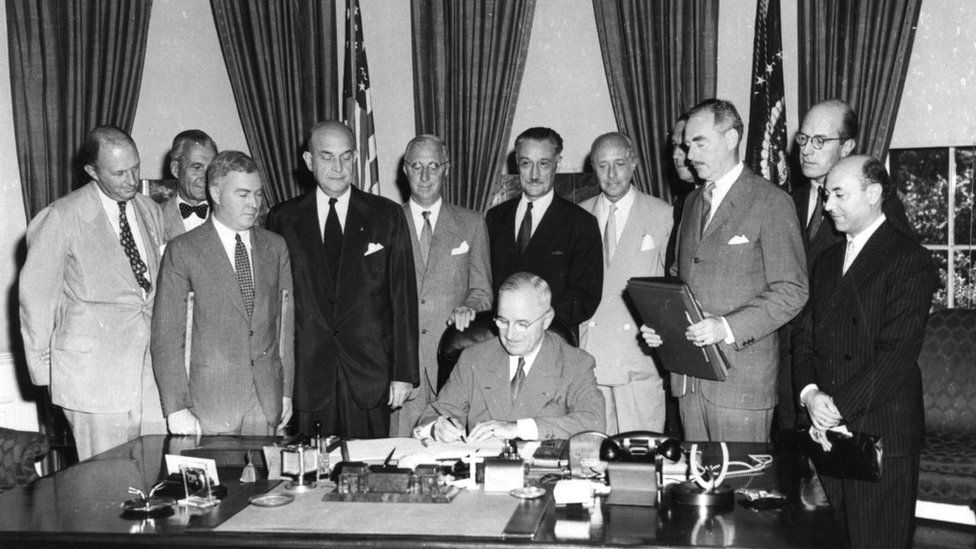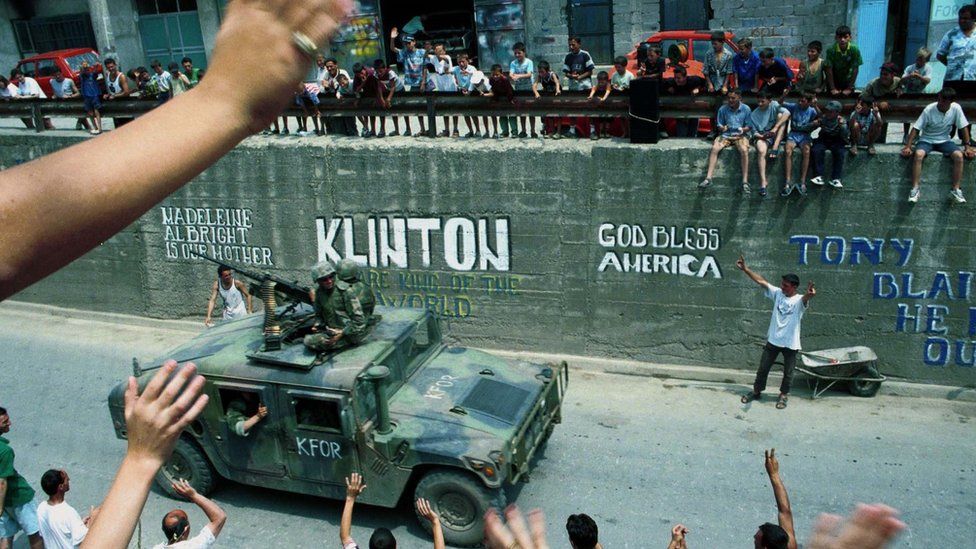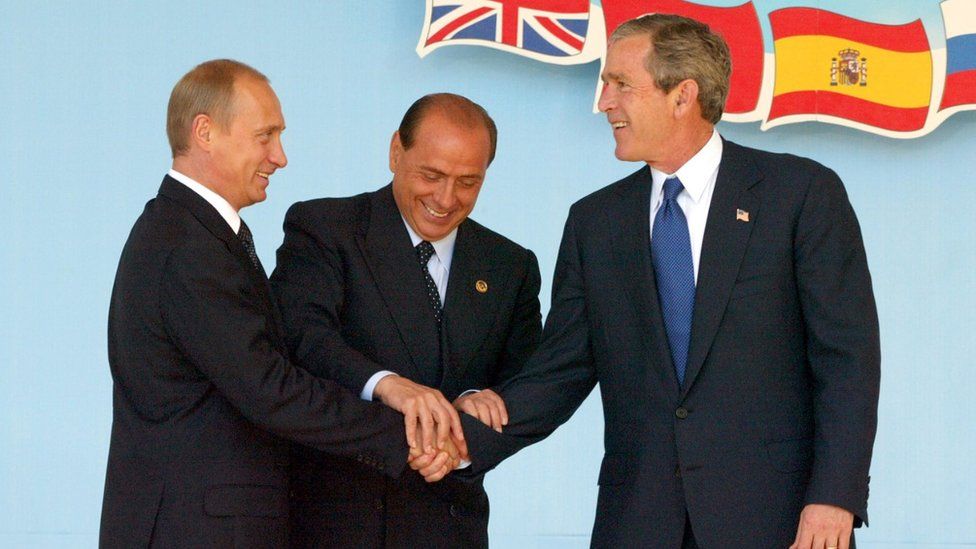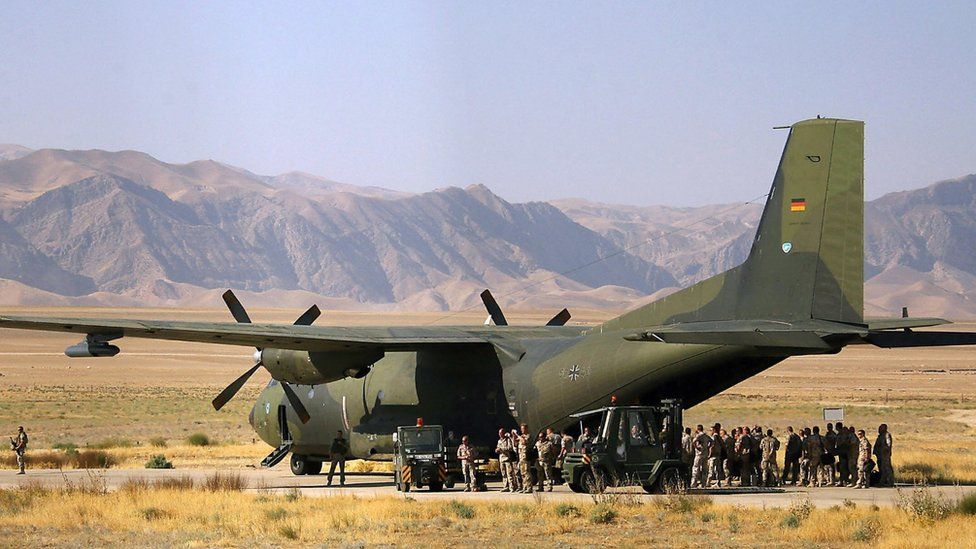Formed in 1949 to counter the threat of post-war communist expansion as the Soviet Union sought to extend its influence in Europe, Nato – the North Atlantic Treaty Organisation – is the world’s most powerful regional defence alliance.
Bạn đang xem: Ussr là gì
It has traditionally stated its general aim as being to “safeguard the freedom, common heritage and civilisation” of its members by promoting “stability and well-being in the North Atlantic area”.
Members agree that an armed attack against one shall be considered an attack against them all, and that they will come to the aid of one another.
Originally consisting of 12 countries, the organisation expanded to include Greece and Turkey in 1952 and West Germany in 1955. However, then, as now, the alliance was militarily dominated by the United States.
In 1955 the Soviet Union created a counter-alliance called the Warsaw Pact, which dissolved after the break-up of the USSR in 1991.
The Czech Republic, Hungary and Poland became the first former Warsaw Pact countries to gain Nato membership in 1999.

The next historic step came in 2004 when Estonia, Latvia and Lithuania, republics of the USSR until its collapse in 1991, along with Slovenia, Slovakia, Bulgaria and Romania were welcomed as Nato members at a ceremony in Washington.
Nato was set up in the post-World War II atmosphere of anxiety, largely to block Soviet expansion into Europe. The collapse of the Soviet Union in 1991 and subsequent demise of the Warsaw Pact, therefore, left Nato with no obvious purpose.
Since then Nato has used its defensive role to justify a more proactive approach to “out of area” activities – arguing that instability in any part of Europe would constitute a threat to its members.
Thus, at the end of 1995 it organised its first ever multinational Implementation Force (Ifor), under a United Nations mandate to implement the military aspects of the Bosnian peace agreement.

In 1999 the alliance launched an 11-week campaign of air strikes against Yugoslavia to push Serb forces out of Kosovo. The strikes were the largest military operation ever undertaken by Nato, and the first time it had used force against a sovereign state without UN approval. The Nato peacekeeping force remains in Kosovo, although it has been scaled down from 16,000 to about 6,000 by 2012.
In 2003 Nato took its operations outside Europe for the first time when it assumed strategic command of the UN-mandated peacekeeping force in and immediately around the Afghan capital, Kabul.
Following the collapse of the Soviet Union in 1991, Nato embarked on a series of steps designed to build new relationships with former Warsaw Pact countries and particularly with Russia, which was profoundly suspicious of the alliance’s plans to expand eastwards.
In 1994 Nato offered former Warsaw Pact members limited associations in the form of the Partnership for Peace programme, allowing them to participate in information sharing, joint exercises and peacekeeping operations.

But this simply appeared to confirm Russian fears that Nato posed a creeping threat to its security.
The Nato-Russia Permanent Joint Council was established in May 1997 to give Russia a consultative role in discussion of matters of mutual interest. While Moscow was given a voice, it rarely felt that it was really listened to.
Xem thêm: Giảm Tiểu Cầu Là Gì ? Triệu Chứng Của Giảm Tiểu Cầu Vai Trò Của Tiểu Cầu Trong Cơ Thể Người
Russia’s fears intensified when in 1999 the Czech Republic, Hungary and Poland became the first former Soviet bloc states to join Nato, bringing the alliance’s borders 400 miles closer to the Russian frontier.
The 11 September 2001 attacks on targets in the US were a pivotal moment for Nato. The US did not involve the alliance in the international military campaign that followed, even though Secretary-General George Robertson quickly invoked Article Five of the Nato constitution declaring an attack on one member to be an attack on all.

Russia’s supportive reaction following the attacks proved to be the catalyst for a thaw in relations with Moscow. The establishment of the Nato-Russia Council was agreed in May 2002. This body gives Russia an equal role with the Nato countries in decision-making on policy to counter terrorism and other security threats.
However, the relationship with Russia continued to be difficult. Russia was unhappy that the Nato expansion of early 2004 brought the alliance to its borders. Relations took a marked turn for the worse after the brief Russo-Georgian war of August 2008, when Nato announced that cooperation would be suspended until Moscow pulled all its troops out of Georgia.
Relations improved after Barack Obama assumed the US presidency in January 2009, and Nato announced in March 2009 that it would be resuming high-level contacts with Russia.
However, relations took a turn for the worse in 2014 when Russia annexed Crimea from Ukraine and was accused of supporting separatist rebels in eastern Ukraine. The developments appeared to give Nato, which some described as a Cold War relic, new relevance.
Secretary-General Jens Stoltenberg said the Ukraine crisis “reminds us just how important Nato is. The idea of collective defence has become more important given how Russia is using force to change borders in Europe.”
Disputes between Germany, France and the US over the 2003 invasion of Iraq caused one of the worst crises in Nato history. The alliance itself played no part in the invasion, although most member countries did. It later assisted in training Iraqi security forces.
Nato has since shaped a new role for itself. It took command of the international peacekeeping force in Afghanistan in 2003 as part of a growing awareness of the global terrorist threat, and set up a 9,000-strong rapid reaction force for swift deployment to trouble spots anywhere in the world.

image captionSoldiers of the Nato-led International Security Assistance Force (ISAF) in Afghanistan in 2006
However, the reluctance of many Nato governments to supply reinforcements for the Afghan mission raised questions about the alliance’s ability to sustain such large-scale operations.
At a key summit held in Lisbon in November 2010 the alliance adopted a new “strategic concept” or mission statement that pledged it to cut costs while prioritising defence against new emerging threats, such as cyber-attacks.
Nato allies also agreed to deploy a missile defence system to cover all of the territory of its European members, complementing US plans for a missile defence shield.
And agreement was secured on moving towards Afghan control of internal security, which is due to begin in July 2011 and envisages full Afghan control by the end of 2014.
The imposition of a no-fly zone over Libya in March 2011 posed a tricky problem for the alliance. Although countries such as Britain and the US were keen for Nato to play a major role in heading the operation, some Arab governments were initially uneasy at the prospect of Nato command.
Following a period of disagreement and confusion, Nato agreed to take on the responsibility of enforcing the no-fly zone, which proved crucial in defeating pro-Gaddafi forces in October.
He has repeatedly complained that Europe’s Nato members are not spending enough on the alliance. In October, he pulled forces out of northern Syria without consulting European Nato members.
Xem thêm: Thanh Toán Tt Payment Là Gì ?, Thanh Toán D/A, D/P Là Gì ? Transfer Payment Là Gì
In November, just a month before the 70th anniversary of Nato, French President Emmanuel Macron described Nato as “brain dead”.
Chuyên mục: Định Nghĩa







